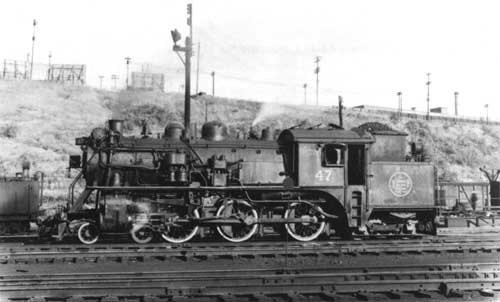|
Steamtown
Steam Over Scranton: The Locomotives of Steamtown Special History Study |

|
CANADIAN STEAM LOCOMOTIVES
It is not the purpose of this study to deal in depth with the history of the railroads whose locomotives are in the Steamtown collection, but a brief characterization of the two principal Canadian railroad systems whose locomotives are numbered among those in Scranton is appropriate.
The Canadian Pacific Railway was incorporated on February 17, 188110 take over a scheme of the Dominion government to build Canada's first transcontinental railroad, connecting the seaboard of British Columbia with the system of railways that already existed in eastern Canada. As was typical of major systems, the Canadian Pacific not only built much new trackage, but also bought up and eventually absorbed various existing railways. The Canadian Pacific received a subsidy of $25 million from the government and obtained exemption from taxation for all time. The Canadian Pacific completed extremely difficult construction across the Laurentian Shield north of the Great Lakes and the Canadian Rockies and the Selkirk Ranges to the Pacific Coast in 1886, and by 1920 had grown to a system of 8,355.9 miles of wholly owned trackage. The main line of the Canadian Pacific extended 2,894.7 miles from Montreal to Vancouver, essentially from the Atlantic to the Pacific. No single American railroad stretched similarly from the Atlantic seaboard to the Pacific Coast. The Canadian Pacific became one of the world's great railroad systems. Despite its government subsidy and exemption from taxation, it has always been essentially a private company.
The Canadian National Railways, in contrast, is a transcontinental railway system operating in many places in competition with the Canadian Pacific, but is a government-owned corporation, in effect a nationalized railway system. While a more recent system than that of the Canadian Pacific, its origins are nevertheless older. From the beginning, railways in Canada's Atlantic provinces had been sponsored and funded by provincial governments. On July 1, 1867. the new government of the Dominion of Canada inherited a collection of comparatively small railways from the provinces of New Brunswick and Nova Scotia. Subsequently the government sponsored and funded a new railway, the Intercolonial, to connect the railways of these maritime provinces with the privately owned railways of Quebec and Ontario. From time to time the government acquired additional railways, and operated them under the title Canadian Government Railways. Meanwhile, around the end of the 19th century, private capital again had undertaken new railway construction, in this case the Canadian Northern Railway built to serve the prairie provinces northwest of the Great Lakes. By 1914, the Dominion government again had a foot in the door, having acquired a considerable block of Canadian Northern common stock in exchange for loans advanced to the Canadian Northern. Again in financial difficulties in 1916, the Canadian Northern passed into the hands of government control, total acquisition being achieved in 1918. On December 20, 1918, the Dominion government established Canadian National Railways, a crown corporation, to place the Canadian Government Railways and the Canadian Northern railway system under a single management.
Another railway system in Canada that had an early start was that of the Grand Trunk Railway, incorporated in 1853 by British investors, and for many years the largest privately owned railway system in Canada. In 1903, the Grand Trunk worked out an agreement with the government of Canada to build a second transcontinental link between the east and the Pacific Coast. The Grand Trunk Railway established a subsidiary, the Grand Trunk Pacific, to build from Winnipeg to Prince Rupert, while the government undertook to build a subsidiary, the National Transcontinental, east from Winnipeg, which, when the Grand Trunk management declined to take over operation of the National Transcontinental, the government assigned to the Canadian Government Railways to operate. In 1919 the Grand Trunk Railway defaulted on Grand Trunk Pacific Railway securities, and it entered a government-managed receivership. Meanwhile, on March 31, 1919, work had begun on consolidating the Canadian Northern with the Canadian Government Railways, and the government legally amalgamated these two lines under Canadian National Railways effective January 20, 1923. The Grand Trunk Pacific Railway legally joined Canadian National Railways on January 30, 1923. Already, in July 1922, the government had included the 3,000 miles of the bankrupt Grand Trunk Railway in the new Canadian National Railways System.
One might suppose that this narrative has nothing to do with United States history, and that the locomotives of Canadian railways, especially a government-owned Canadian railway, and locomotives built in Canada, have no place in an American railroad museum operated by the United States National Park Service. However, a number of historic factors undercut any such assumption.
Perhaps least significant, many Americans involved themselves in the building and operating of Canadian railroads. William Cornelius Van Home, who built the Canadian Pacific across the great Pacific Coast mountain ranges, is only one example of an American in Canadian employ, though perhaps the most notable one. Michael Heney, who became a distinguished railroad engineer, was another American who worked on the Canadian Pacific.
Somewhat more important, although Canada established an efficient locomotive-building industry of its own, its locomotive works tended to follow American practice so that most Canadian-built locomotives were similar in appearance to American-built locomotives, in vivid contrast to the extreme physical differences between American and Canadian locomotives on the one hand and European locomotives on the other. Furthermore, while the Canadian government and the Canadian Pacific owned some American railroads, for many years the American Locomotive Company owned and controlled the Montreal Locomotive Works. In more than one sense, then, the Canadian locomotive-building industry was an extension of the American locomotive-building industry.
Of much greater importance in establishing a connection between Canadian and American railroads historically, is a fact that would surprise most Americans: a significant part of the American railroad system has historically been owned or controlled by the two great Canadian railway systems. The original Grand Trunk Railway included lines in New England, the ultimate consequence of which was that the Canadian National Railways owned and controlled the Central Vermont Railway. Furthermore, Canadian National Railways owned and controlled another major American railroad, the Grand Trunk Western Railroad in Michigan and Illinois, which not only connected Chicago and Detroit but provided Detroit with its only commuter service. How many commuters riding behind Grand Trunk Western Locomotive No. 6038, a sister to the 6039 at Steamtown, realized that the company carrying them was owned by the government of Canada? Not only did the Canadian National Railways own railroads incorporated and operating in the United States, so did the Canadian Pacific Railway. Many Americans have heard of the "Soo Line," the Minneapolis, St. Paul and Sault Saint Marie Railway operating across North Dakota, Minnesota, Wisconsin, and Michigan, mostly west of the Great Lakes on the prairies. Few of them probably ever realized that the "Soo was owned and controlled by Canada's great private railway system, the Canadian Pacific. The Canadian Pacific also owned and controlled the Duluth, South Shore and Atlantic Railway, operating mostly in Michigan between Duluth, Minnesota, and Sault Saint Marie. Thus the two great Canadian railway systems are inextricably linked with the history of a number of railroads in the United States.
While the trains of these Canadian-owned American railroads carried their own names and employed locomotives and cars built in the United States, it is also true that a section of main line of the Canadian National Railways (formerly Canadian Northern) crosses roughly 25 miles of the northeast
corner of Minnesota, over which Canadian National locomotives operated, and to get from Montreal to Fredericton, New Brunswick, Canadian Pacific locomotives had to cross the state of Maine. Not only did Canadian locomotives operate over these lines, they regularly crossed the border into the United States in New England in interchange service, although customs regulations required that once a Canadian locomotive was uncoupled from its train at the end of a trip, the next train to which it was coupled it had to lead back into Canada. It is therefore necessary to recognize that Canadian Pacific and Canadian National locomotives, lettered for those lines, regularly operated within the United States. Additionally, Canadian Pacific kept certain locomotives in the United States for switching and short runs. Canadian Pacific even acquired and operated a former Boston & Maine shop at Lyndonville, Vermont.
The following chapters discuss the various Canadian locomotives in the Steamtown collection.
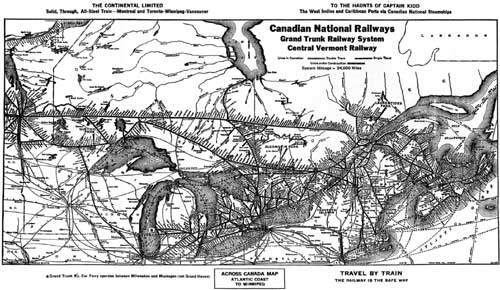
Canadian National Railways route map
(click on the above for an enlargement in a new window)
BIBLIOGRAPHY
Arrey, K.J., and W.G. Blevins. "Canadian Rolling Stock Developments," Chapter 7 in Railway Mechanical Engineering, A Century of Progress, Car and Locomotive Design. New York: The American Society of Mechanical Engineers, Rail Transportation Division, 1979: 171-183.
Barnes, Michael. Link with a Lonely Land: The Temiskaming and Northern Ontario Railway. Erin: The Boston Mills Press, 1985.
Berton, Pierre. The National Dream: The Great Railway, 1871-1881. Toronto: McClelland and Stewart, Ltd., 1970.
__________. The Last Spike: the Great Railway, 1881-1885. Toronto: McClelland and Stewart, Ltd., 1971.
__________. The Great Railway Illustrated. Toronto: McClelland and Stewart, Ltd., 1972.
Booth, J. Derek. Railways of Southern Quebec, Vols. 1 and 2. Toronto: Railfare Enterprise: Ltd., 1982, 1985.
Bowers, Peter. Two Divisions to Bluewater: The Story of the CNR to the Bruce. Erin: The Boston Mills Press, 1983.
Canadian Rail, Journal of the Canadian Railroad Historical Association.
Clegg, Anthony, and Ray Corley. Canadian National Steam Power. Montreal: Trains & Trolleys, 1969.
Corey, Raymond F. Preserved Canadian Railway Equipment. Montreal: Railfare Enterprises, Inc., n.d.
Cruise, David, and Alison Griffiths. Lords of the Line. New York: Viking Penguin, Inc., 1988.
Dean, Murray W., and David B. Hanna. Canadian Pacific Diesel Locomotives. Toronto: Railfare Enterprises, Ltd., 1981.
Dempsey, Hugh A. The CPR West: The Iron Road and the Making of a Nation. Vancouver: Douglas and McIntyre, Ltd., 1984.
Dorm, Patrick. Canadian Pacific Railway: Motive Power, Rolling Stock, Capsule History. Seattle: Superior Publishing Company, 1974.
__________. The Canadian National Railway's Story. Seattle: Superior Publishing Company, 1975.
__________. The Grand Trunk Western Railroad: A Canadian National Railway. Seattle: Superior Publishing Company, 1977.
__________. The Soo Line. Seattle: Superior Publishing Company, 1979.
Eagleson, Michael A. "The Last Years of Canadian Pacific Steam." Railroad Magazine, Vol. 85, No. 6, 1969: 18-27.
Gibbon, John Murray. The Romantic History of the Canadian Pacific: The Northwest Passage of Today. New York: Tudor Publishing Company, 1937.
Hart, E.J. The Selling of Canada: The CPR and the Beginnings of Canadian Tourism. Banff: Altitude Publishing, Ltd., 1983.
Holt, Jeff. The Grand Trunk in New England. Toronto: Railfare Enterprises, Ltd., 1986.
Gilbert, Heather. The Life of Lord Mount Stephen. Aberdeen: Aberdeen University Press, 1977.
Hungry-Wolf (Gutohrlein), Adolf. Rails in the Canadian Rockies. Invermere: Good Medicine Books, 1979.
Innis, Harold A. A History of the Canadian Pacific Railway. Toronto: University of Toronto Press, 1971.
Lamb, W. Kaye. History of the Canadian Pacific Railway. New York: Macmillan Publishing Company, Inc., 1977.
Lavallee, Omer. Van Horne's Road: An Illustrated Account of the Construction and First Years of Operation of the Canadian Pacific Transcontinental Railway. Toronto: Railfare Enterprises, Ltd., 1974.
__________. Canadian Pacific Steam Locomotives. Toronto: Railfare Enterprises, Ltd., 1985. [This is one of the best histories of the motive power of a particular railway company ever published if not the best.]
__________, and Robert Brown. "Locomotives of the Canadian Pacific Railway Company," Railway & Locomotive Historical Society Bulletin, No. 83 (July 1951): 7-93.
Legget, Robert F. Railways of Canada. Vancouver: Douglas and McIntyre, Ltd., 1987.
MacKay, Donald. The Asian Dream: The Pacific Rim and Canada's National Railway. Vancouver: Douglas and McIntyre, Ltd., 1986.
MacKay, Niall. By Steam Boat and Steam Train: The Story of the Huntsville and Lake of Bays Railway and Navigation Companies. Erin: The Boston Mills Press, 1982.
Mackenzie, Keith, ed. A History of the Canadian National. London: Bison Books, 1988. McDougall, J. Lome. Canadian Pacific. Montreal: McGill University Press, 1968.
McKee, Bill, and Georgeen Klassen. Trail of Iron: The CPR and the Birth of the West, 1880-1930. Vancouver: Douglas and McIntyre, Ltd., with the Glenbow-Alberta Institute, 1983.
Mika, Nick, Helma Mika, and Donald Wilson. Illustrated History of Canadian Railways. Belleville: Mika Publishing Company, 1986.
Morgan, David P., ed. Canadian Steam. Milwaukee: Kalmbach Books, 1975.
Riegger, Hal. The Kettle Valley and its Railways. Edmonds: Pacific Fast Mail Publications, n.d.
Stevens, G.R. Canadian National Railways, Vol. I: Sixty Years of Trial and Error, 1836-1896. Vancouver: Clarke, Irwin & Company, Ltd., 1960.
__________. Canadian National Railways, Vol. II: Towards the Inevitable, 1896-1922. Vancouver: Clarke, Irwin & Company, Ltd., 1962.
_________. History of the Canadian National Railways. New York: The Macmillan Company, 1973.
Turner, Robert D. West of the Great Divide: An Illustrated History of the Canadian Pacific Railway in British Columbia, 1886-1986. Victoria: Sono Nis Press, 1987.
CANADIAN NATIONAL RAILWAYS NO. 47
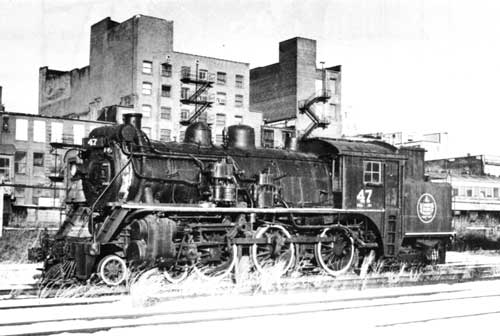
Owner(s):
Grand Trunk Railway 1542
Canadian National Railways 47
Whyte System Type: 4-6-4T "Baltic tank"
Class: X-10-a Series of six, Nos. 45-50
Builder: Montreal Locomotive Works
Date Built: September 1914
Builder's Number: 54896
Cylinders (diameter x stroke in inches): 21 x 26
Boiler Pressure (in lbs. per square inch): 210
Diameter of Drive Wheels (in inches): 63
Tractive Effort (in lbs.): 32,487
Tender Capacity:
Coal (in tons): 5
Oil (in gallons): Not applicable
Water (in gallons): 2,900
Weight on Drivers (in lbs.): 146,000
Remarks: Used in Montreal suburban (commuter) service.
Canadian National Railways 4-6-4T Locomotive No. 47
History: Canada's Grand Trunk Railway had been incorporated in 1853, financed by investors in Great Britain, and became for many years the largest and longest privately owned railway in Canada, operating principally in eastern Canada and controlling the Grand Trunk Western Railroad in Michigan and the Central Vermont in New England. The Canadian government, meanwhile, had become involved in financing railways by making loans in exchange for stock and had inherited other railroads as early as during the creation of the Dominion in 1867. These operated in eastern Canada under the name Canadian Government Railways. Subsequently the government acquired control of the Canadian Northern Railway, and on December 20, 1918, consolidated the two operations as Canadian National Railways, a government-owned Crown corporation. Later the government acquired and added to this corporation the Grand Trunk Railway and the Grand Trunk Pacific Railway, thus establishing by 1923 a transcontinental railway system in competition in many areas with the privately owned transcontinental, the Canadian Pacific Railway.
While the Grand Trunk Railway still rested in private hands, in 1914 the company purchased for Montreal suburban service six 4-6-4T (or 4-6-4FT) "Baltic tank" locomotives from the Montreal Locomotive Works. "Suburban" meant that this class of locomotives had been designed for and employed in the service of hauling commuters between the suburbs and a major Canadian city, in this case, Montreal, and "tank" meant that it was an engine with its tender carrying coal and water integral with the main frame of the locomotive, rather than in the form of a separate "tender" car semipermanently coupled to the locomotive; in other words, the locomotive had no tender, but instead had a tank for water and bin for coal built right onto the extended locomotive frame behind the cab where normally a tender would be coupled. For reasons unknown, this class received the type name of "Baltic tank," though the wheel arrangement, ignoring the tank aspect, was that of a Hudson type.
The suburban tank locomotive had a long history of development and use in the United States as well as in Canada, particularly around Boston, Chicago, and, more important, New York City. The New York Central operated 2-4-4Ts, the Boston and Albany and the Chicago and Northern Pacific each operated 2-6-6Ts, and even the Illinois Central operated tank locomotives in suburban service. Canada, however, and the Montreal Locomotive Works specifically, seems to have been first to develop the 4-6-4T type.
In the United States, however, the Central Railroad of New Jersey, which operated a large volume of commuter service around New York City using four-coupled locomotives, began around the turn of the century seeking heavier motive power for its suburban trains, and in 1902 and 1903 purchased from the Baldwin Locomotive Works a number of 2-6-4T locomotives that proved quite successful, but with time the need for power exceeded even their capacity, and in 1923 the Central of New Jersey had the Baldwin Locomotive Works design and build six 4-6-6T Baltic tank-type locomotives. In an article published three years later in Baldwin Locomotives, the quarterly house organ of the Baltimore Locomotive Works, Paul Warner described the characteristics of these first American 4-6-4T locomotives:
Grand Trunk Railway Locomotive No. 1542, later Canadian National Railways No. 47, served as a suburban 4-6-4T engine on commuter trains operating in the vicinity of Montreal. Today, it is the only engine of its type surviving in the United States. This series of CNR suburban engines probably inspired the design of a very similar class of 4-6-4T suburban engines purchased by the Central Railroad of New Jersey for commuter service around New York. Unfortunately, none of the American copies of this Baltic tank type of locomotive were preserved, and only this single Canadian specimen is left in the United States to represent the type.
Top, collection of Gerald Best, California State Railroad Museum Library.
Bottom, Colorado Railroad Museum LibraryThese locomotives were designed to traverse curves of 20 degrees, and had flanged tires on all the wheels. Both trucks were of the swing bolster pattern with three-point suspension links, the front truck being center bearing and the rear truck side bearing. The latter was placed under the tank, which was of the water-bottom type. The rear frame, on which the tank was carried, was of steel, cast in one piece with the truck center plate, draft gear housing, rear bumper and tank supports.
These locomotives used superheated steam, and the distribution was controlled by piston valves 11 inches in diameter. The Walschaerts valve gear was used in conjunction with a power reverse mechanism. . . .
The boiler was of the wagon-top type, with a wide firebox placed above the main and rear drivers. The fuel used was a mixture of anthracite and bituminous coal, and the grates were of the rocking pattern, arranged to shake in four sections. Feedwater heating equipment was applied, with a heater of the closed type placed above the smokebox in front of the stack. The smokebox shell was depressed on top, in order to keep the drum and piping within the limit of height. The feed-water pump, and also the air pump, were placed on the left side. The saving in water consumption effected by the feed-water heater has proved of special benefit to these locomotives, on account of their limited tank capacity.
While the greater part of the suburban traffic on the New Jersey Central [sic] is now being worked by locomotives with separate tenders, the double-ender tank locomotives have proved practically indispensable on certain short runs where facilities for turning the engines are lacking. The locomotives operate in either direction with equal facility, and are well liked by the enginemen.
Similar qualities characterized the earlier Canadian 4-6-4T locomotives.
In fact, the Central Railroad of New Jersey 4-6-4Ts were quite similar in appearance and some vital statistics to the earlier Grand Trunk Railway Baltic tank engines. Both types had 63-inch drive wheels and cylinders 21 inches in diameter with a 26-inch stroke. The Canadian engines carried 210 pounds per square inch of steam pressure in the boiler, compared with 200 for the Central of New Jersey engines. In appearance the locomotives were sufficiently similar that a layman might not notice subtle differences: The steps between the pilot deck and the running boards were much closer to the cylinders on the American than on the Canadian engines, and the American engine had a two-segment running board most of which was higher, over the air pumps rather than beneath them; a curved skirt beneath the cab connected with the cab steps on the Canadian locomotive that the American engines lacked; the cab window arrangement differed on the locomotives, as did the size and shape of the tender tank and coal bin; the third pair of drive wheels was spaced the same distance from the second as the second from the first on the American engine, but on the Canadian locomotive was spaced much further back; the pilot wheels of the Canadian engine were spoked, but on the American engine had solid centers; and there were many other minor differences.
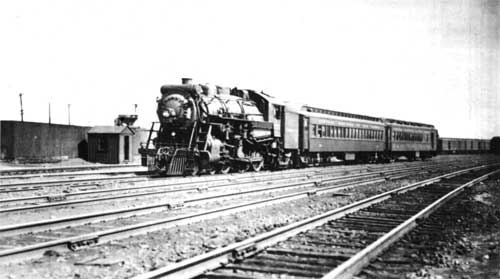
Remarkably similar in appearance to the Canadian National 4-6-4T Baltic
tank-type locomotives whose design they had inspired, a Central Railroad
Company of New Jersey suburban tank locomotive, No. 225, hurried along
with a local train outbound from Jersey City on October 4, 1936. As not
a single locomotive of this type was preserved in the United States,
only a Canadian stepchild of this American 4-6-4T, Canadian National
Railways No. 47, exists in the United States to represent this type.
Bruce D. Fales photo, Steamtown National Historic Site
Interestingly, a year earlier than Baldwin built these well-known American Baltic tanks, in 1922, the American Locomotive Company built a single Baltic tank locomotive for singularly obscure service. The Tennessee Coal, Iron and Railroad Company was an outgrowth of a firm dating from 1860 in Tennessee that operated an extensive network of coal mines, iron ore mines, quarries, coke ovens, and blast furnaces, originally in Tennessee and later in Alabama. Most of its blast furnaces, foundries, rolling mills, and eventually steel works lay in the district around Birmingham, Alabama, in Jefferson County, though some facilities were in Tuscaloosa, Walker, Blount, and Shelby counties, Alabama, and other plants were in Franklin and Marion counties, Tennessee. The firm employed principally 0-6-0 and 0-4-0T switchers.
With the main thrust of its business moved to the western area around Birmingham, Alabama, the Tennessee Coal, Iron and Railroad Company needed to provide transportation for its workers between the city and the mines. In 1922 the firm ordered from the Richmond Locomotive Works of the American Locomotive Company a single 4-6-4T locomotive to be numbered 450. The Tennessee Coal, Iron and Railroad Company placed it in service hauling a company commuter passenger tram connecting downtown Birmingham, at a depot at 14th Street and 1st Avenue, North, with company mines at Hamilton, Edgewater, Docena, Wenonah, Ishkoda, and Muscoda, Alabama, and possibly others. The Depression killed this traffic about 1932, after which the company used Locomotive No. 450 as a hostler's switcher. The Tennessee Coal, Iron and Railroad Company finally retired the locomotive and cut it up for scrap in 1945.
The Grand Trunk Railway 4-6-4T locomotives, meanwhile, continued routinely to haul commuters in and out of Montreal and to and from its suburbs. The same year that the Central Railroad of New Jersey ordered six similar locomotives, the Canadian National Railways absorbed into its roster the Grand Trunk Railway 4-6-4T locomotives, numbered 1540-1545, renumbered as 45 through 50, and in the process No 1542 became No. 47, a number it retained for the rest of its service.
Canadian National Railways Locomotive No. 47 never operated historically in the United States, until in June 1959, after the company had retired it, the Canadian National sold the locomotive for $2,000 f.o.b. Montreal to Nelson Blount's Edaville Railroad for exhibit in the United States. Blount subsequently transferred the locomotive to North Walpole, New Hampshire, and then briefly operated it on the Clarement and Concord Railroad. However, the locomotive's official records had been destroyed in a roundhouse fire on the Canadian National, and Blount could not document the condition of its flues, so the Interstate Commerce Commission ordered the locomotive retired until it could either be documented or be reflued.
This Canadian National Railways Baltic tank locomotive, built in September 1914, is the only one of its type in the United States, none of the American locomotives of this type having survived. Furthermore, as this locomotive and sisters of her class predate by the better part of a decade the one American 4-6-4T built in 1922 and the six built in 1923, it seems likely that they influenced the design of the American locomotives.
Two sister 4-6-4T locomotives of the same class survive in Canada, No. 46 at Longueuil, Quebec, and No. 49 in the Canadian Railway Museum at Delson, Quebec.
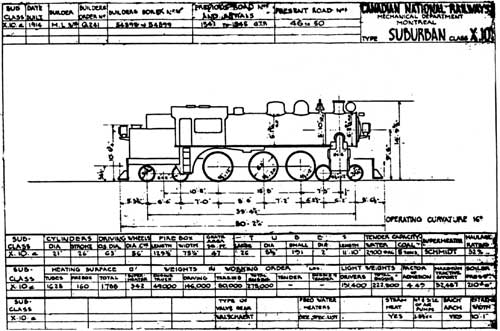
Canadian National Railways locomotive diagram
Condition: Canadian National Railways Locomotive No. 47 reportedly is in fairly good condition and could be made operable with an overhaul, probably involving reflueing of the boiler.
Recommendation: This locomotive is the only 4-6-4T Baltic tank locomotive in the United States and a rare surviving example of a suburban locomotive of which no American-made examples exist. The NPS should commission a report on the subject of this locomotive; the report should be exhaustively researched in the Montreal region to ascertain what changes in appearance and fabric may have taken place over the career of this locomotive. The report should then recommend whether to restore this as a Canadian National locomotive or a Grand Trunk Railway locomotive. At the minimum, it should be restored cosmetically for exhibit purposes indoors, and, if feasible, it should be restored mechanically to operable condition, and operated occasionally for interpretive purposes.
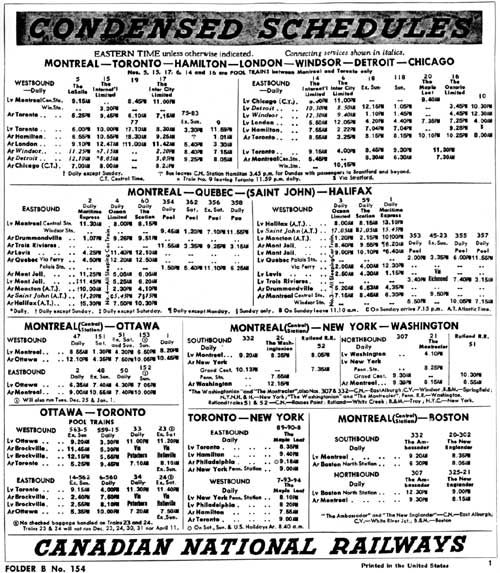
Canadian National Railways Condensed Schedule, from a November 5, 1951
timetable.
BIBLIOGRAPHY
Canadian National Railway Form CNR-41 11/11-58, Sales Order No. S-19802 & 3, Montreal, Quebec, June 17, 1959.
A Catalogue . . . Descriptive of Simple and Compound Locomotives Built by the Brooks Locomotive Works, Dunkirk, N.Y., U.S.A. Dunkirk: Brooks Locomotive Works, 1899: 214, 215.
Clegg, Anthony, and Ray Corley. Canadian National Steam Power. Montreal: Trains and Trolleys, 1969: 24-26, 66-67.
Dorin, Patrick C. Commuter Railroads: A Pictorial Review of the Most Travelled Railroads. New York: Bonanza Books, 1967: 67.
Kerr, O.M. Illustrated Treasury of the American Locomotive Company. n.p.: A Delta Publication, n.d.
Lawson, Thomas. Letter to author, Nov. 9, 1988.
Locomotive Cyclopedia of American Practice, 1925. New York: Simmons-Boardman Publishing Corp., 1925: 193.
Official Steamtown Locomotive Guide, Vol. 1 -- 1970 . Bellows Falls. Vt.: Steamtown Foundation for the Preservation of Steam and Railroad Americana, Inc., 1970, n.p.: page on CNR No. 47.
Staufer, Alvin F. Steam Power of the New York Central System. n.p.: Alvin F. Staufer, 1961: 178-179.
Warner, Paul. "Locomotive Development on the Central Railroad of New Jersey." Baldwin Locomotives, Vol. 8, No. 1 (July 1926): 11-13.
CANADIAN NATIONAL RAILWAYS NO. 3254
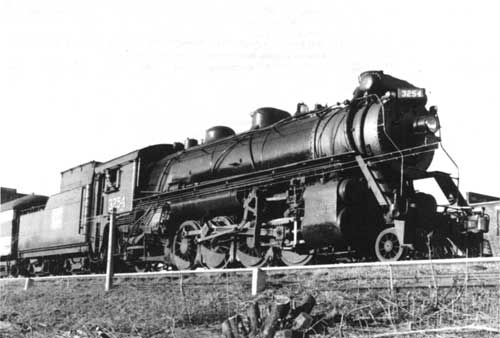
Owner(s):
Canadian Government Railways 2854
Canadian National Railways 3254
Whyte System Type: 2-8-2 "Mikado"
Class: S-1-b
Builder: Canadian Locomotive Company, Kingston Works
Date Built: 1917
Builder's Number: 1497
Cylinders (diameter x stroke in inches): 27 x 30
Boiler Pressure (in lbs. per square inch): 180
Diameter of Drive Wheels (in inches): 63
Tractive Effort (in lbs.): 53,115
Tender Capacity:
Coal (in tons): 17
Oil (in gallons): Not applicable
Water (in gallons): 7,200
Weight on Drivers (in lbs.): 277,500 (also reported as 209,970)
Remarks: Acquired from Gettysburg Railroad in 1987 in purchase/trade for Canadian Pacific Railway 4-6-2 No. 1278 plus $100,000. Engine is operable.
Canadian National Railways 2-8-2 Locomotive No. 3254
History: Locomotive No. 3254, a "Mikado" type, often known colloquially as a "Mike," rolled out of the Canadian Locomotive Company's works at Kingston, Ontario, for use on the Canadian Government Railways in 1917 as No. 2854. With the power of the public treasury behind it, Canadian Government Railways was assembling a large stable of modern motive power in 1917 that included 2-8-0s, 2-8-2s, 4-6-2s, and 2-10-2s, despite the fact that Canada had for three years been fully engaged in World War I against the Central Powers as a Dominion under the British Crown. Furthermore, Canadian Government Railways characteristically ordered locomotives built with enclosed "all-weather" cabs to provide the engine crew protection against the harsh Canadian winters, so these locomotives constituted the latest in motive power of their types.
Canadian Government Railways had a very brief existence. Canada had a long tradition of government ownership of railways, both provincial and federal (Dominion) ownership, mostly in eastern Canada, though Canada also had many privately owned and operated railroads. But on April 1, 1916, the Dominion government consolidated five of its railways under a new government-owned entity, the Canadian Government Railways: they were the Intercolonial Railway with 1,527 miles of main line, the Transcontinental Railway, the Prince Edward Island Railway with 276 miles of narrow gauge, the 36-1/2-mile New Brunswick and Prince Edward Island Railway, and the National Transcontinental with 1,814 miles of track extending west to Winnipeg. In May 1917, the Canadian Government Railways bought Class S-1-b 2-8-2 No. 2854, among others of its type, and that same year went on to add the International Railway of New Brunswick, and in 1918, the company swallowed the Elgin and Havelock Railway's 26 miles, the 30 miles of the Moncton and Buctouche Railway, the St. Martin's Railway's 28 miles, the 44.77-mile Salisbury and Albert Railway, and the mere 6-mile-long York and Carleton Railway. All of these lines lay east of Montreal except for the main line from Quebec to Winnipeg, Manitoba. A bit later the Caraquet Railway joined Canadian Government Railways, bringing 68 miles of main line into the system. By March 31, 1919, the company owned 767 locomotives, 725 passenger train cars, 26,878 freight cars, and 728 service cars. But its brief existence neared termination.
On September 6, 1918, the Dominion government appointed a new board of directors for its newly acquired, though privately built and operated, Canadian Northern Railway, and recognized that it needed to combine this new acquisition west of Lake Superior on the prairies with its lines east of Montreal that constituted the Canadian Government Railways. On November 20, 1918, the Canadian government assigned the new Canadian Northern directorate responsibility for administering the Canadian Government Railways, and on December 20, 1918, an Order-in-Council directed the board henceforth to refer to both systems as the Canadian National Railways. Thus, the Canadian Government Railways, large as the system was, lasted as a distinct entity for less than three years, although consolidation of the two systems did not begin until March 31, 1919, and the amalgamation was not legally complete until January 20, 1923.
The operational history of this Class S-1-b Mikado is not known, but the locomotive received its last shopping, class 3 repairs, at Allendale, Ontario, in February 1958. Canadian National probably retired the locomotive then or shortly thereafter and put it in storage.
In November 1961, Willis F. Barron of Ashland, Pennsylvania, purchased the locomotive with the intention of operating it, apparently on a Reading branch that served Ashland, but by the time he was able to move the locomotive, the Reading Company had abandoned and dismantled the branch. Barron had to dismantle the locomotive into its major components--frame and wheels, boiler, cab, tender--and truck it into Ashland where he apparently reassembled the locomotive on the grounds of his Ashland Court Motel, but he never bolted the parts together; the cab, for example, simply sat in place, held by its own weight. With his plans for operating the locomotive dismantled along with the nearby Reading branch, he sold the locomotive to the Adirondack Railroad near Lake Placid, New York, but that outfit never completed paying for the locomotive, and consequently never took delivery.
In 1982, the Gettysburg Railroad purchased No. 3254 from Barron and trucked it, again broken down into major components, along with one or more passenger cars Barron had owned, to Gettysburg, Pennsylvania.
The Gettysburg Railroad operated some 25 miles of track between Gettysburg and Mount Holly Springs, Pennsylvania, which had once been the Reading Company's Gettysburg-Harrisburg Branch. One of the recent trends in American railroading has been the bankruptcy and collapse of a number of major railroad systems, the Reading among them, and the practice of entirely new small firms of private entrepreneurs, often railroad enthusiasts at heart, purchasing abandoned but not yet dismantled sections of main or branch lines and placing them back into revenue service using diesel-electric locomotives, in many cases hauling diesel-powered passenger excursions and, in some cases, acquiring steam locomotives and operating summer steam passenger excursions. The Gettysburg Railroad, among these, resumed common-carrier freight service between Gettysburg and Mount Holly Springs on October 15, 1976, and, after a few special passenger excursions, began regular passenger excursion service in May 1978. Eventually the company acquired a 2-8-0, No. 76, from the Mississippian Railway, to enable it to offer steam-powered excursions, and in 1982 it purchased Canadian National No. 3254.
The latter locomotive, once overhauled, reassembled, and placed in service, did not really meet the Gettysburg Railroad's excursion needs, for it was too large and too heavy a locomotive.
In the summer of 1987, however, the Steamtown Foundation, operating an excursion line from Scranton toward Pocono Summit, Pennsylvania, did need just such a locomotive. At that time the Steamtown Foundation needed an operable, heavy-duty locomotive. The time required to do the repair work on suitable Steamtown motive power was not available, and while the foundation at that time had a fair amount of money, it was out of time, and had to run diesel motive power on its supposed-to-be-steam excursion train. Consequently, Steamtown traded Canadian Pacific Railway 4-6-2 No. 1278 plus $100,000 for the Gettysburg Railway's operable Canadian National Railway No. 3254. The Gettysburg Railroad got a fairly light Pacific-type locomotive suitable to their needs, and the Steamtown Foundation got a fairly heavy Mikado suitable, though not really a passenger engine, for their heavier duty needs.
The Steamtown Foundation lettered its new acquisition "Lackawanna" in honor of the original builder of the railroad on which it now was to operate, and gave it the fictional number 1271, which would have been the number assigned to the last Lackawanna Mikado had the Lackawanna owned one more engine of that class than it did: the last Delaware, Lackawanna & Western Mikado had been No. 1270. In the transformation of the Canadian engine into a "Lackawanna" engine, the Steamtown shop removed the raised numbers 3254 under the cab windows, removed the distinctively Canadian National angled number boards from on top of the smokebox, replacing them with headlight number boards apparently from a Delaware, Lackawanna & Western electric car, and otherwise changed the appearance of the locomotive to represent more closely that of a true Lackawanna 2-8-2. In August 1987, the 1271 went into service hauling the Steamtown passenger excursion so that Canadian Pacific Locomotive No. 2317 could enter the Scranton Shops for repairs.
No. 3254 (a.k.a. 1271) is the only S-1-b class Mikado preserved, but a somewhat similar locomotive of predecessor class S-1-a, No. 3239, built two years earlier than No. 3254, is preserved by the Canadian Railway Museum at Delson, Quebec.
Condition: Locomotive No. 3254 is an operable locomotive, subject to the usual running repairs and periodic inspection and overhaul.
Recommendation: Canadian National Railways Locomotive No. 3254 is a historic locomotive that should be preserved and could be used to operate an excursion train. The Steamtown collection does not include any American Mikado type 2-8-2 locomotives, but counting Canadian National No. 3377, it has two Canadian Mikados. Until Steamtown National Historic Site can acquire an American 2-8-2, it should retain these two Canadian Mikados as representative of that wheel arrangement. This report leans toward No. 3377 as the later and less altered of the two Mikados to become a museum exhibit locomotive, rather than 3254, which can be used in passenger excursion service.
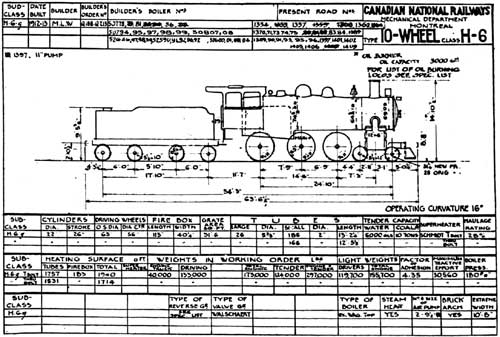
Canadian National Railways locomotive diagram
BIBLIOGRAPHY
Clegg, Anthony, and Ray Corley. Canadian National Steam Power. Montreal: Trains & Trolleys, 1969: 27, 91.
Cornell, Jim. Telephone interview with author, Jan. 8, 1991.
"Railnews," Railfan and Railroad. Vol. 6, No. 11 (Sept. 1987): 32, 33.
"Railnews," Railfan and Railroad. Vol. 6, No. 13 (Nov. 1987): 38-39.
Steam Passenger Service Directory, 1989. Richmond, Vermont: Locomotive & Railway Preservation, 1989: 17.
CANADIAN NATIONAL RAILWAYS NO. 3377
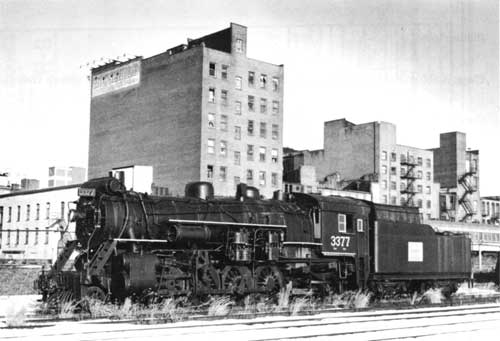
Owner(s):
Canadian Government Railways 2977
Canadian National Railways 3377
Whyte System Type: 2-8-2 "Mikado"
Class: S-1-d
Builder: Canadian Locomotive Company, Kingston Works
Date Built: 1919
Builder's Number: 1582
Cylinders (diameter x stroke in inches): 27 x 30
Boiler Pressure (in lbs. per square inch): 180
Diameter of Drive Wheels (in inches): 63
Tractive Effort (in lbs.): 53,115
Tender Capacity:
Coal (in tons): 17
Oil (in gallons): Not applicable
Water (in gallons): 7,200
Weight on Drivers (in lbs.): 277,550 (also reported as 209,970)
Remarks: Has mechanical stoker. Sold to Edaville in September 1961. Engine needs repairs; "jewelry" or certain small parts are missing.
Canadian National Railways 2-8-2 Locomotive No. 3377
History: This locomotive, built as Canadian Government Railways No. 2977 in 1919, was turned out by the Canadian Locomotive Company in Kingston, Ontario, just in time to be relettered Canadian National and renumbered 3377. The engine was quite similar to No. 3254, though two years younger, carried the same cylinder and driver measurements and boiler pressure, and produced the same tractive effort, but because of minor differences was classified by the Canadian National as a Class S-1-d. A typical freight locomotive, No. 3377 featured in later years a mechanical stoker, a superheater, a feedwater heater, and large-capacity air pumps for the braking system, allowing it to haul long main line freight trains. Soon the Canadian National Railways, once equipped with a stable of locomotives of this type, was able to retire a lot of decrepit 4-4-0s and 2-6-0s that it had inherited from predecessor railroads.
The operational history of this locomotive is not known.
Condition: No. 3377 reportedly is in relatively good condition with low mileage since its last overhaul. Most of its "jewelry" is missing, i.e., brass fittings in and outside of the cab including such items as gauges, copper pipes, and the like. Most of this material was deliberately removed before the move from Canada to Bellows Falls, Vermont. The locomotive could be overhauled and placed back in service.
Recommendation: As one of the two "Mikado" type locomotives at Steamtown, this locomotive should be preserved to represent its type. It may also be used in excursion train service.
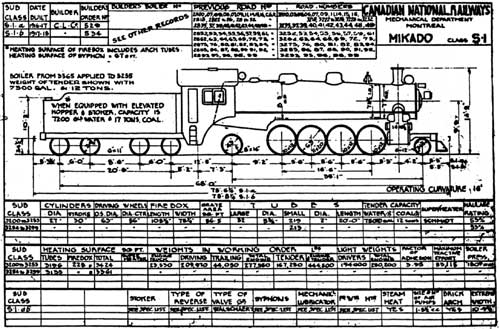
Canadian National Railways locomotive diagram
BIBLIOGRAPHY
Clegg, Anthony, and Ray Corley. Canadian National Steam Power. Montreal: Trains & Travel, 1969: 29-32, 91.
Guide to the Steamtown Collection. Bellows Falls, Vt.: Steamtown Foundation, n.d. (ca. 1973), Item No. 41 and roster entry.
CANADIAN NATIONAL RAILWAYS NO. 5288
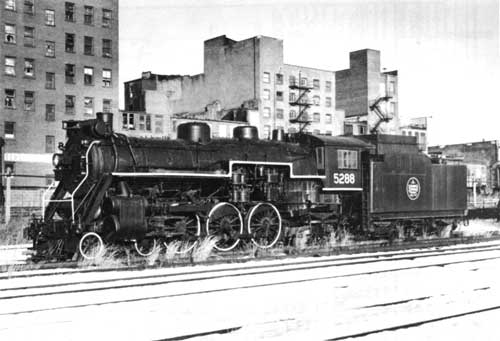
Owner(s):
Canadian Government Railways 516
Grand Trunk Railway 1516
Canadian National Railways 5288
Whyte System Type: 4-6-2 "Pacific"
Class: J-7-b
Builder: Montreal Locomotive Works
Date Built: 1918
Builder's Number: 60483
Cylinders (diameter x stroke in inches): 24 x 28
Boiler Pressure (in lbs. per square inch): 200
Diameter of Drive Wheels (in inches): 69
Tractive Effort (in lbs.): 39,735
Tender Capacity:
Coal (in tons): 14
Oil (in gallons): Not applicable
Water (in gallons): 7,100
Weight on Drivers (in lbs.): 268,000 (also reported as 174,000)
Remarks: Has superheater. This engine has low mileage since last overhaul. Some "jewelry" or small parts are missing.
Canadian National Railways 4-6-2 Locomotive No. 5288
History: Canadian National Railways' medium-size 4-6-2 "Pacific"-type Class J-7 locomotive rolled out of the Montreal Locomotive Works in 1919. The rapid corporate reorganizations coupled with Canadian government acquisition of private railway companies then taking place in Canada and the creation, while this locomotive was being built, of the Canadian National Railways on December 20, 1918, left this locomotive with a particularly complicated conception. Canadian National motive power historians Anthony Clegg and Ray Corley outlined the situation:
Ownership of several orders placed by the Federal Government [of Canada] through the Canadian Government Railway for assignment to the various [rail]roads was vested in 'Canadian National Rolling Stock Limited.' Essentially similar locomotives owned by the latter company, but operated initially on different railways, were occasionally modified to suit the practice of the operating line. For example, the twenty J-7 Class locomotives constructed for the CGR's use, (later CN 5250-5279) had closed cabs in keeping with the rigors of the Canadian winter; the fifteen J-7 engines destined for Grand Trunk use [including No. 5288], however, were given open cabs, in line with GTR practice.
Thus No. 5288 originated as one of a series of locomotives ordered under the name of the Canadian Government Railway in June 1918 as Nos. 508 through 522 (No. 5288 would have been originally No. 516) nearly six months prior to the actual creation of the Canadian National Railways. Even before these engines were completed, the Canadian Government Railway earmarked this particular series of locomotives for use on the Grand Trunk Railway, also ordering modification of the cab specifications from an all-weather enclosed cab to an open cab, exposed at the rear except for cab curtains. Though it was carried on Canadian Government Railway books as No. 516, the company had the builder modify the order prior to delivery, renumbering the series 1508 through 1522, so that 516 became 1516, in order that these engines not duplicate the numbers of a series of Grand Trunk Railway 2-8-2 locomotives already numbered in the 500 series. It is unlikely that any of these locomotives ever carried their originally assigned 508 through 522 numbers; when the Montreal Locomotive Works turned them out, they were undoubtedly numbered in the 1509 through 1522 series, and although some of them, possibly even No. 516, may originally have carried lettering for Canadian Government Railways, those must have been quickly relettered "Grand Trunk."
On paper, the engines were taken over by Canadian National Railways in September 1919, although with other Canadian Government Railways motive power, and between October 1920 and March 1921 they were renumbered as Canadian National Railways 5280 through 5294, while still leased to the Grand Trunk Railway. In another paper transfer, in 1922 the Canadian National Railways sold the 15 locomotives, still carried on the books as owned by Canadian Government Railways though it no longer existed as a separate operating company, to the Grand Trunk. In March 1923 in yet another paper transfer, Canadian National again picked up the 15 locomotives in its records, although listing them as owned by the Grand Trunk.
The addition of the J-7 class locomotives, and many other new locomotives, resulted, in 1923, in the retirement of many old 4-4-0 and 2-6-0 locomotives as the newer, heavier power class took over their assignments. Grand Trunk No. 1516, subsequently Canadian National No. 5288, handled principally passenger trains in eastern Canada.
Operating for the Grand Trunk, the locomotive had "Grand Trunk" spelled out on each side of the cab and on each side of the flange of the tender near the top front, with a large number 1516 on the side of the tender, probably all in white. Later renumbered as 5288, it carried a white number on each side of the cab and the Canadian National's name spelled out in a tilted box on each side of the tender.
A detailed history of the use of this locomotive over the years awaits research in Canada. At one time the engine apparently hauled international trains into White River Junction, Vermont, so that it can be said to have operated historically within the United States, even if only in across-the-border service. By 1956 it was assigned to haul commuter trains in the vicinity of Montreal, where it operated out of the huge engine house at Turcot, Quebec. It was there that boiler inspector J.O. Carrier reported the locomotive in good condition on the Monthly Locomotive Boiler Inspection and Repair Report for July 1957, when the date for boiler tube (flue) removal was extended to September 13, 1957. When F. Nelson Blount acquired the locomotive in September 1961 and moved it to Edaville, Massachusetts, and later to Steamtown at Bellows Falls, Vermont, the engine reportedly was operable, or nearly so.
Very similar in design to the "standard" 4-6-2 design adopted by the United States Railroad Administration during World War I, this locomotive was typical of 4-6-2s that operated all over North America in the 1920s through 1950s. They served on both main lines and branch lines, and though generally considered passenger train locomotives, they occasionally pulled freight. Representing the Grand Trunk Railway as well as the Canadian National, this locomotive has New England associations, for the Grand Trunk operated in New England as well as Canada.
Out of the 186 J class and 135 K class Canadian National 4-6-2s built, a total of 321 engines, only 12 have survived, 3 of them Grand Trunk Western locomotives that historically operated entirely within the United States. No. 5288, however, is the only survivor of the 15 J-7-b class of locomotives, the variant with the GTR-style open cabs, although J-7-a No. 5270 with the CGR-style all-weather enclosed cab survives in a park in Moncton, New Brunswick. No. 5288 is one of about 57 4-6-2 locomotives preserved in the United States, six of which are Canadian Pacific engines, one--No. 5529--a Canadian National engine, and three of them the aforementioned Grand Trunk Western locomotives. No. 5288 represents a good example of mid-20th century steam motive power.
Condition: Reportedly the locomotive is in fairly good condition, with low mileage since its last major overhaul, but it also has much of its "jewelry" missing--the brass-rimmed gauges, brass valve levers, and other appurtenances in the cab and elsewhere that attract thieves of brass or railroad artifacts--though some of these items may be in Steamtown storage.
Recommendation: The locomotive type No. 5288 represents, the 4-6-2 "Pacific" type, is also represented in the Steamtown collection by Boston & Maine No. 3713. It should be noted that No. 5288 is known to have pulled international trains across the Canadian border into the United States at least as far as White River Junction, Vermont, and No. 5288 could represent that history of a Canadian National Railways locomotive actually operating in common-carrier service in the United States.
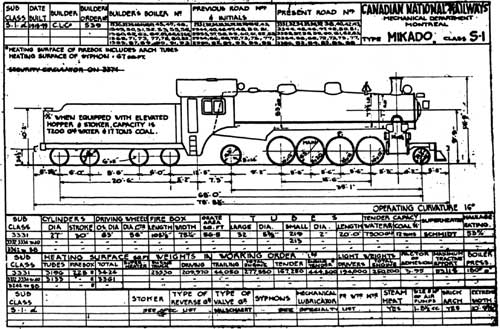
Canadian National Railways locomotive diagram
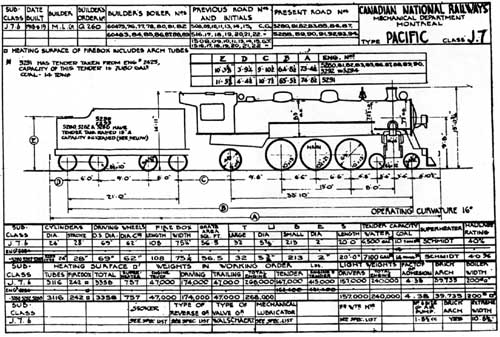
Canadian National Railways folio locomotive diagram sheet documented the vital
statistics of Locomotive No. 5288.
Canadian National Railways
BIBLIOGRAPHY
Clegg, Anthony, and Ray Corley. Canadian National Steam Power. Montreal: Trains & Trolleys, 1969: 29, 30, 99.
Guide to the Steamtown Collection. Bellows Falls, Vt.: Steamtown Foundation, n.d. (ca. 1973), Item No. 44 and roster entry.
Kean, Randolph. The Railfan's Guide to Museum & Park Displays. Forty Fort: Harold E. Cox, Publisher, 1973: 175.
CANADIAN PACIFIC RAILWAY NO. 1293
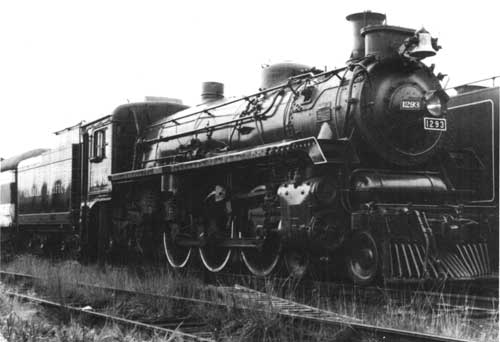
Owner(s):
Canadian Pacific Railway 1293
Whyte System Type: 4-6-2 "Pacific"
Class: G-5-d
Builder: Canadian Locomotive Company
Date Built: June 1948
Builder's Number: 2450
Cylinders (diameter x stroke in inches): 20 x 28
Boiler Pressure (in lbs. per square inch): 250
Diameter or Drive Wheels (in inches): 70
Tractive Effort (in lbs.): 34,000
Tender Capacity:
Coal (in tons): 14
Oil (in gallons): Not applicable
Water (in gallons): 8,000 (Imperial gallons)
Weight on Drivers (in lbs.): 151,000
Remarks: This locomotive can be made operable with some work. Sold January 1964 to Steamtown.
Canadian Pacific Railway 4-6-2 Locomotive Number 1293
History: "No railroad has contributed more toward the perfection of the steam locomotive in North America than the Canadian Pacific," wrote locomotive historian F. H. Howard as the opening sentence of his article in Trains & Travel Magazine on Canadian Pacific's last series of 4-6-2 locomotives, built on the evening before diesel dominance transformed North American railroads. He went on to say, "Its progressive attitude has been especially apparent in boiler matters: the first superheater, the first nickel-steel barrel, and the world's largest collection of welded boilers all breathed steam into CPR cylinders."
Henry Vaughan, in charge of Canadian Pacific Railway motive power, initiated construction of the railway's first two series of 4-6-2 or "Pacific"-type locomotives in 1905 to meet the demands of rapidly expanding passenger train service. Class G-l locomotives with 75-inch drive wheels would pull passenger traffic over main lines in relatively flat terrain such as the prairies of central Canada. The G-2 class with smaller 69-inch drivers would be assigned to trains in hilly country. These engines began rolling out of the erecting shops in 1906, and during the next seven years before World War I, Canadian Pacific placed more than 200 of them in service. Then after the war ended in 1918, the company went on to build, for the most part, larger and heavier power.
In March 1911, G-l No. 1011 appeared with a completely enclosed "all-weather" or "vestibule" cab, a feature destined to become common on Canadian locomotives that greatly increased the comfort and safety of the engine crew.
It was during the long tenure of Henry Blame Bowman as chief mechanical officer of the Canadian Pacific (1928 to 1949) that the company again envisioned a need for smaller classes of locomotives. Bower had presided over the development of such behemoths as 2-10-4s and modern 4-6-4s, but in 1935 his office designed the first of two classes of streamlined 4-4-4 locomotives intended to haul the new high-speed, "lightweight" passenger trains. Then in 1943, Bower's office designed a new class of 4-6-2 locomotives. The Canadian Pacific in 1944 still operated 495 Vaughan Class D-10 4-6-0s and 150 Vaughan Class G-l and G-2 4-6-2s, but all were more than 30 years old and beginning to wear out. The question of replacing this rapidly aging fleet of small locomotives for postwar assignments to principally secondary and branch lines concerned Bower. Locomotives Nos. 1200 and 1201 of the new class, which rolled out of Canadian Pacific's Angus Shops in April and June, 1944, was a modernized version of the Vaughan Class G-2 4-6-2 of 1906.
The railway sent No. 1200 out west and assigned No. 1201 to the Montreal-Perth passenger run. No. 1201, incidentally, proved to be the last steam locomotive to be built in the Canadian Pacific Railway's own shops, though the railroad would order a hundred more of these Pacifics from the Montreal Locomotive Works and the Canadian Locomotive Company.
Trains Magazine reported on the new class of light Pacifics in its July 1944 issue, featuring a builder's photo of No. 1200 and a description of their features:
The design of these Pacifics, Class G-5, is based on the earlier Class G-2, but the engine has been modernized and lightened. The portion of the cab extending forward over the fire box has been eliminated and the cab upper structure has been made of aluminum. The boiler steam dome was omitted, following the recent trend. Engine trucks are fitted with roller bearings. Morel-metal staybolts are used experimentally where it was customary to use flexible staybolts in the past, and one locomotive is fitted with a complete installation of Morel-metal staybolts on one side and standard steel staybolts on the other side.
The weight distribution of the new G-5's is such that they can be used on most of the CP's branch lines. It is proposed that this design will eventually replace 495 of the D-10 class Ten-Wheelers, and 150 of the G-1 and G-2 class Pacifics, engines which were built in the early years of the century and which were originally used on mainline trains row hauled by heavy Pacifics.
The Canadian Pacific eventually purchased three subclasses of G-5 Pacifics, the first two locomotives forming Class G-5-a, built in 1944. Montreal Locomotive Works produced the first G-5-b in August 1945, 13 more in September, 13 more in October, and one in November 1945. It rolled out one each in January 1946 and April 1946. Fifteen of these 30 locomotives went into service or western lines, 15 to eastern Canada. Then in 1946, the company produced four of a new subclass of G-5-c, 11 more in June and five more in July.
Production then switched to the Canadian Locomotive Company, which produced two G-5-c locomotives in September 1946, nine in November 1946, and three in December 1946. That company turned out two more in January 1947 and another four in April 1947. After a hiatus of a year, the Canadian Locomotive Company produced sever of the new subclass of G-5-d in April 1948, then went on to produce eight more in May, seven more in June (of which No. 1293 was the last of the month's production), four more in July, and four more in August 1948, No. 1301 being the last steam locomotive built for the Canadian Pacific Railway.
All G-5 4-6-2s featured 70-inch diameter drive wheels, cylinders 20 inches in diameter, with a 28-inch stroke, 250-pounds-per-square-inch boiler pressure, and tractive effort of 34,000 pounds, and were identical in most other dimensions, variance between the G-5-a and G-5-b through -d subclasses consisting only of difference in some weights and appliances. All had Elesco Type A superheaters and HT-1 type mechanical or automatic stokers. The G-5-b type differed from G-5-a locomotives in Elesco exhaust steam injectors under the fireman's side of the cab. The G-5-c subclass featured a coaming around the top of the water compartment or the tender and differently located injector piping than predecessors had. The Class G-5-d engines of 1948 featured a revised Elesco feedwater heater in the smokebox, with a water pump on the left side of the boiler.
The operational history of locomotive No. 1293 awaits further research in Canadian archives.

The Canadian National Railway photographed 4-6-2 No. 1200, first of the
new series of light "Pacific" type locomotives built during the and after
World War II. This original model of the G-5 class rolled out of the
Canadian Pacific's own Angus Shops in 1944.
Canadian National Railways
F. Nelson Blount purchased the locomotive for excursion service on the Green Mountain Railroad out of the Riverside Yards north of Bellows Falls, Vermont. He purchased Locomotive No. 1293 in the name of the Green Mountain Railroad in January 1964. The Steamtown Foundation purchased No. 1293 from the Green Mountain Railroad in 1973.
Rebuilt in 1976, No. 1293 was the first Steamtown locomotive to be given an overhaul since F. Nelson Blount's death in 1967, nearly a decade earlier. After being broker in on the excursion train in June 1976, No. 1293 powered the state-funded Vermont Bicentennial Train over 13,000 miles that year, featuring a green and black color scheme for that use.
In 1979, the Steamtown Foundation leased No. 1293 to a Hollywood company for the filming in Canada of a motion picture starring Jamie Lee Curtis entitled Terror Train. The film company renumbered the locomotive "1881" and painted it black with silver stripes, along with the five Steamtown cars used with the engine in filming near Montreal. As implied by the title, the film was a typical horror film involving a number of gruesome murders during a college fraternity excursion party aboard the train.
In 1980, the Steamtown Foundation restored No. 1293 and relettered it Canadian Pacific, painting it in the black, gold, and Tuscan red CPR passenger color scheme that had been inspired by a 1933 visit to Canada and the Chicago World's Fair of a British train in maroon and gold livery, the Royal Scot, whose colors the Canadian Pacific had begun copying between 1933 and 1936. The restoration of the locomotive to a historic color and lettering scheme proved immensely popular among railroad enthusiasts, who descended on Steamtown in droves for the annual "Railfan Weekend" photography spree. But there was no documentation to prove that No. 1293 ever had that particular color scheme historically.
On February 4, 1982, the locomotive was in the Steamtown storage and shop building when it collapsed at 7:45 a.m. under an unusually heavy load of several feet of fresh wet snow, damaging the upper parts of the locomotive, including such features as headlights, handrails, cab roof, and the like.
In Canada, the second of this series of G-5 locomotives, Pacific No. 1201, is preserved by the National Museum of Science and Technology in Ottawa, Ontario, and is used on occasion for excursion service. It is the only one of the G-5 type in Canada.
Condition: No. 1293 is basically an operable locomotive, given some routine repairs.
Recommendation: This type of locomotive did operate into New England occasionally, perhaps as far south as Boston in international service. While perhaps too light to handle long excursion trains on the stiff climb to Pocono Summit, this locomotive might be usable for smaller special trains or for occasional use on other lines in the Scranton vicinity.
BIBLIOGRAPHY
"Awaiting Departure." Railfan and Railroad, Vol. 5, No. 4 (May 1984): 28-29. Bailey, Frederick G. "Steam and Snow." Rail Classics, Vol. 10, No. 3 (May 1981): 16-21.
Guide to the Steamtown Collection. Bellows Falls, Vt.: Steamtown Foundation, n.d. (ca. 1973), Item Nos. 19, 31, 32, and roster entries.
Howard, F.H. "Famous Steam Locomotives: 23; Destined to Die Young," Trains & Travel, Vol. 14, No. 4 (Feb. 1954): 51-53.
Kean, Randolph. The Railfan's Guide to Museum & Park Displays. Forty Fort: Harold E. Cox, Publisher, 1973: 174.
Lavallée, Omer. Canadian Pacific Steam Locomotives. Toronto: Railfare Enterprises Ltd., 1985: 184-222, 304, 400, 401, 421, 437, 441.
Locomotive Cyclopedia of American Practice, 1947. New York: Simmons-Boardman Publishing Corp., 1947: Section 2, 163, Section 3, 169.
"Photo Gallery," Rail Classics, Vol. 7, No. 4 (July 1978): 28, 29.
"Photo Line," Railfan, Vol. l, No. 10 (Spring 1977): 34-35.
"Postwar Locomotives," Trains, Vol. 4, No. 9 (July 1944): 40.
"Railnews: Disaster at Steamtown, Railfan and Railroad, Vol. 4, No. 4 (May 1982): 22.
"Railnews: Railfans' Railroad," Railfan and Railroad, Vol. 3, No. 3 (Mar. 1980): 2.
"Steam News Photos," Trains, Vol. 26, No. 6 (Apr. 1966): 14; Vol. 26, No. 11 (Sept. 1966): 13.
"Steam Photo Gallery," Rail Classics Steam Special No. 2: 58-59.
Steamtown News, 1970.
"Steamtown Update," Railpace Newsmagazine, Vol. 3, No. 11 (Nov. 1984): 3, 18.
"Steamtown USA: 'A Championship Season,'" Railpace Newsmagazine, Vol. 3, No. 12 (Dec. 1984): 18-21.
"What's Happening," Rail Classics, Vol. 7, No. 5 (May 1978): 50-51; Vol. 9, No. 3 (May 1980): 54.
"Winter Weekend Preview," Railfan, Vol. l, No. 5 (Winter 1975): 32-33.
CANADIAN PACIFIC RAILWAY NO. 2317
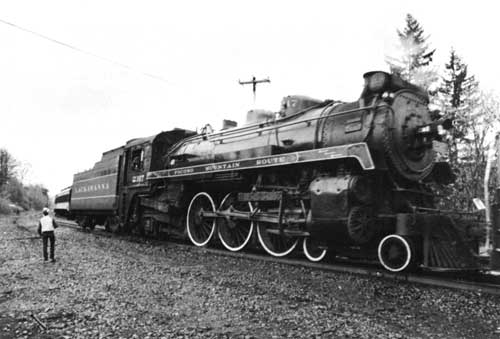
Owner(s):
Canadian Pacific Railway 2317
Whyte System Type: 4-6-2
Class: G-3-c
Builder: Montreal Locomotive Works
Date Built: June 1923
Builder's Number: 64541
Cylinders (diameter x stroke in inches): 25 x 30
Boiler Pressure (in lbs. per square inch): 200
Diameter of Drive Wheels (in inches): 75
Tractive Effort (in lbs.): 42,600
Tender Capacity:
Coal (in tons): 17
Oil (in gallons): Not applicable
Water (in gallons): 12,000 (Imperial gallons)
Weight on Drivers (in lbs.): 181,500
Remarks: Sold November 1965 to Steamtown, in 1986 and 1987 this locomotive operated excursions out of Scranton.
Canadian Pacific Railway 4-6-2 Locomotive No. 2317
History: Before the Canadian Pacific built the small 1200-series G-5 "Pacific"-type locomotives to replace earlier classes of ten-wheelers and light Pacifics, the railroad had acquired a much heavier class of 4-6-2 locomotives for main line passenger traffic.
William H. Winterrowd had become chief mechanical officer of the Canadian Pacific Railway (CPR) in April 1918 as the World War was winding down. Under his supervision, and possibly that of his predecessor, wartime chief mechanical officer William E. Woodhouse, the drafting office had prepared designs for no less than four new postwar heavier and more powerful locomotives of the 2-8-2, 2-10-2 and 4-6-2 wheel arrangements (two classes of the latter). First to be constructed, ten new 2-8-2 Mikado types of Class P-2-a rolled out of CPR's erecting shops in April and July, 1919. Last to be produced, Winterrowd's 15 Class S-2-a 2-10-2 locomotives constituted at the time CPR's heaviest freight motive power, following the successful 2-10-0s Woodhouse had introduced.
For passenger service, CPR needed heavier locomotives because "heavyweight" six-wheel truck all-steel cars had rapidly replaced the older, lighter wooden passenger cars on main line runs. Building on Vaughan's successful G-l and G-2 Pacifics manufactured well before the World War, Winterrowd's team produced plans for four G-3-a 4-6-2s with 75-inch drive wheels for service over relatively flat terrain and five G-4-a Pacifics with smaller 70-inch drivers for main line service in hilly terrain. Numbered 2300 through 2303, one of the G-3-a locomotives appeared in July 1919 and the other three in August. Construction of this type would resume with the G-3-b subclass in 1920 and extend with variations through G-3-j subclasses. Locomotive No. 2317, the eighteenth of the G-3 series, would be the seventh in the G-3-c subclass, which with its predecessors in that subclass was outshopped in June 1923. By that tine Charles H. Temple had succeeded Winterrowd as chief of motive power and rolling stock. Two more G-3-cs, Nos. 2318 and 2319, also came Out in June, followed by six more in July, before the railroad began procuring the next G-3 subclass, the G-3-d. These were the first locomotives in North America to have nickel steel boilers and the first Canadian Pacific engines to be built new with feedwater heaters. Whereas all the G-3-a and G-3-b subclasses had been built at CPR's own Angus Shops, the G-3-c and G-3-d locomotives were erected by the Montreal Locomotive Works. Ultimately, the CPR acquired 173 G-3 4-6-2 locomotives in nine subclasses.
The G-4 class began coming out in October 1919, and totaled only 18 locomotives built in 1919, 1920 and 1921.
The operational history of G-3-c locomotive No. 2317 awaits further research in Canada, but the locomotive is known to have been stationed in Winnipeg, Manitoba, for many years. Canadian Pacific apparently retired the locomotive from service and put her in stored status in 1959, after 36 years of operation.
F. Nelson Blount acquired the locomotive for Steamtown at Riverside near Bellows Falls, Vermont, in November 1965, but the Steamtown Foundation did not restore No. 2317 to serviceability until 1978, more than a decade after Blount's death in 1967.
Because of the locomotive's overall excellent condition, Steamtown began its overhaul in March 1976 so it could pull a bicentennial train known by the unwieldy title of Vermont Bicentennial Steam Expedition sponsored by the State of Vermont. Steamtown was to have the locomotive serviceable by July. But it turned out that the engine had an axle loading too heavy for a few wood bridges between Riverside and Chester. Steamtown instead assigned a lighter and more modern CPR 4-6-2, No. 1293, to haul the Vermont bicentennial train, and suspended work on No. 2317. Steamtown's shop did not resume work on the overhaul of No. 2317 until June 1978. in order to place it in service by the Annual Railfan's Weekend that October. On October l, 1978, engineer Andy Barbera opened the throttle on a live No. 2317 for the first time in 19 years. On October 24, 1978, Steamtown posed the locomotive on a bridge at Rockingham, Vermont, for an "official" portrait.
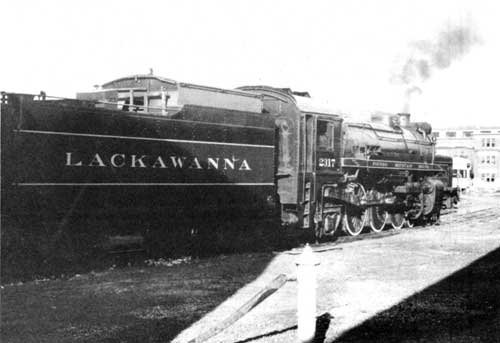
The Steamtown Foundation in Scranton operated Canadian Pacific Railway
Locomotive No. 2317 with a fictional Delaware, Lackawanna & Western
Railroad color and lettering scheme because it was in use on trackage
that originally belonged to the Lackawanna.
Photo by Frank Ackerman
Steamtown had repainted No. 2317 in a CPR gray and Tuscan red passenger train color scheme, a pattern apparently inspired in 1933 by operation across Canada and to Chicago for the World's Fair of a British train in maroon and gold "livery" named the Royal Scot. Canadian Pacific had originally adopted that color scheme between 1933 and 1936. The response of the public and railroad enthusiasts to the appearance of No. 2317 in this color scheme proved to be so enthusiastic that the following year, 1979, Steamtown repainted and relettered G-5s Nos. 1246 and 1278 in the same dark red and gray colors.
On February 4, 1982, the collapse of the Steamtown shop and storage building under the weight of three feet of heavy, wet snow caused some damage to this locomotive, though it was not serious.
After the decision to move Steamtown from near Bellows Falls, Vermont, to the Consolidated Rail Corporation yards at Scranton, Pennsylvania, No. 2317, dead, and a baggage car, four former Delaware, Lackawanna & Western "Boonton" coaches, and an Erie-Lackawanna business car pulled by Boston & Maine, Delaware & Hudson, and Norfolk & Western diesels arrived in Scranton on January 31, 1984. On Saturday, February 4, 1984, a Steamtown crew steamed up No. 2317 for a well-publicized "Grand Entrance" of Steamtown to Scranton at 2 p.m. that day. Mayor McNulty praised all concerned in Steamtown's move to Scranton and declared, "In Scranton, the light at the end of the [Nay Aug] tunnel was an oncoming train!"
At 10:47 am. Saturday, September l, 1984, No. 2317 headed Steamtown's first revenue excursion train out of Scranton for Elmhurst, Pennsylvania, with nine passenger cars. Steamtown had decked the locomotive out in red, white, and blue bunting and American flags for the occasion. Bill Chaplik commented in Railpace Newsmagazine "If steam engines had a soul, and I'm not so sure they don't, 2317 might have thought this a little peculiar considering her Canadian heritage, but she accepted her new status as an American citizen with dignity and put on her best show for everyone. Her Canadian builders would have been proud." During September and October 1984, Steamtown's first operating season in Pennsylvania, No. 2317 hauled about 45,000 riders, compared with only 60,000 during the entire six-month season in Vermont in 1983; lack of patronage due to distance from centers of population was one of the reasons Steamtown left Vermont.
During the winter of 1984-1985, Steamtown undertook the overhaul of No. 2317, and began the 1985 excursion season on March 23 using No. 1246, but No. 1246 soon developed a crack in the firebox and Steamtown had to resort to the use of diesels, for 2317 was still in the shop. As repair of No. 2317 neared completion, the shop force bolted the left cylinder head in place, and then found a large crack that could not be repaired. A new left cylinder head had to be manufactured from 6-inch-thick steel boiler plate, which took a full month. It was not until mid-September 1985 that No. 2317 returned to service, and a number of other problems plagued the locomotive for several weeks, not uncommon in the case of a newly shopped engine. By the close of the 1985 season on October 27, No. 2317 operated well and with relatively little trouble, but Steamtown had used diesels so much that year that the foundation was subjected to a storm of scorn and criticism.
In 1986, No. 2317 went back into excursion service, but with the tender lettered "Lackawanna" and the running board skirts lettered "Pocono Mountain Route," a nonhistoric color scheme on this Canadian locomotive intended to harmonize with the trackage over which it operated, which at one time had been a part of the Delaware, Lackawanna & Western Railroad. Again in 1987, No. 2317 was down for repairs, which forced the Steamtown Foundation in August to purchase another locomotive, this one a former Canadian National Mikado, from the Gettysburg Railroad.
No G-3-c 4-6-2 locomotives survive among the 29 Canadian Pacific locomotives preserved in Canada, but a very similar G-3-d. No. 2341, built by the Montreal Locomotive Works in 1926, is preserved in the Canadian Railway Museum in Delson, Quebec.
Condition: Locomotive No. 2317 is essentially a serviceable locomotive with suitable running repairs and periodic inspection and overhaul.
Recommendation: Because the Pacific type is well represented in the Steamtown collection by an American locomotive, Boston & Maine No. 3713, Canadian Pacific No. 2317 should be used as excursion train motive power.
BIBLIOGRAPHY
B & M [Boston & Maine] Bulletin, Vol. 11, No. 4 (Summer 1982): 35.
Chaplik, Bill. "Steamtown USA Startup!" Railpace Newsmagazine, Vol. 3, No. 10 (Oct. 1984): 33, 34.
"Editorial: Steam's Up!" Railpace Newsmagazine, Vol. 3, No. 11 (Nov. 1984): 3.
Guide to the Steamtown Collection. Bellows Falls, Vt.: Steamtown Foundation n.d. (ca. 1973), Item No. 37 and roster entry.
Lavallée, Omer. Canadian Pacific Steam Locomotives. Toronto: Railfare Enterprises Ltd., 1985: 159-183, 308-310, 315, 400-401, 420, 421, 437, 441, 449.
"Photo Gallery." Rail Classics, Vol. 8, No. 3 (May 1979): 58.
"Photographing the Steamtown Excursion Train." Railpace Newsmagazine, Vol. 3, No. 10 (Oct. 1984): 35-37.
"Railnews." Railfan and Railroad, Vol. 3, No. 3 (Mar. 1980): 2; Vol. 4, No. 4 (May 1982): 22; Vol. 5, No. 4 (May 1984): 28, 29.
"Railroad News Photos." Trains, Vol. 44, No. 7 (May 1984): 16.
"Steamtown: A Championship Season." Railpace Newsmagazine, Vol. 3, No. 12 (Dec. 1984): 18-21.
Steamtown News Special Edition. n.p., n.d. (ca. 1979): 4, 5.
"Steamtown: Railfan Weekend '85." Railpace Newsmagazine, Vol. 4, No. 12 (Dec. 1985): 19-22, back cover.
"Steamtown Update." Railpace Newsmagazine, Vol. 3, No. 11 (Nov. 1984): cover, 16-19.
"Steamtown USA." Railpace Newsmagazine, Vol. 6, No. 2 (Feb. 1987): 30.
"Then and Now." Railpace Newsmagazine, Vol. 5, No. 7 (July 1986): 16, back cover.
Trains, Vol. 39, No. 4 (Feb. 1979): 2.
In the Steamtown files are some Canadian Pacific Railway mileage and shopping records for this locomotive that would facilitate preparation of its operational history.
CANADIAN PACIFIC RAILWAY NO. 2816

Owner(s):
Canadian Pacific Railway 2816
Whyte System Type: 4-6-4 Hudson
Class: H-1-b
Builder: Montreal Locomotive Works
Date Built: December 1930
Builder's Number: 68535
Cylinders (diameter x stroke in inches): 22 x 30
Boiler Pressure (in lbs. per square inch): 275
Diameter of Drive Wheels (in inches): 75
Tractive Effort (in lbs.): 45,300
Tender Capacity:
Coal (in tons): 17
Oil (in gallons): Not applicable
Water (in gallons): 12,000 (Imperial gallons)
Weight on Drivers (in lbs.): 186,900
Remarks: Sold January 1964 to Steamtown.
Canadian Pacific Railway 4-6-4 Locomotive No. 2816
History: By the 1920s, with conversion completed of passenger rolling stock on the Canadian Pacific Railway from older wooden cars to heavier, all-steel six-wheel truck equipment on main line trains (the railroad had 96 such steel cars in 1918, 707 in 1930), the need for passenger motive power still heavier than the 4-6-2 G-3 and G-4 class Pacifics had become evident.
Henry Blame Bowen became chief of motive power and rolling stock on CPR on September l, 1928, a position he was to hold for 21 years. His long tenure, despite the handicaps of the depression which began in 1929 and World War II, which began in 1939, was second only to that of Vaughan in production of new locomotives, totaling 462 steam locomotives and including many new designs, such as F-1 and F-2 4-4-4s, H-1 4-6-4s, T-1 2-10-4s, U-5 0-8-0s, and G-5 4-6-2s. "An unyielding advocate of steam up to the moment of his retirement," commented Canadian Pacific locomotive historian Omer Lavallée, "Bower was largely responsible for retaining this form of motive power for road operations long after many major North American carriers had thrown in their lot with the diesel-electric locomotive."
Immediately upon assuming his new duties as chief of motive power and rolling stock in 1928, Bower began formulating his own motive power policy, which, unlike that of his predecessor, Charles H. Temple, focused on new designs. The first two, produced by the drawing office on October 1, 1928, called for a Class H-1 4-6-4, or "Hudson" type, essentially an enlargement or development beyond the G-3 and G-4 4-6-2s and intended to replace them in main line passenger service, and a Class Q-1 2-8-4 intended similarly as a development beyond the Class P 2-8-2s as a new and heavier freight locomotive. Omer Lavallée observed:
In each case, the provision of a four-wheeled trailing truck would permit the use of a [mechanical] stoker, redesigned boiler with larger firebox capacity, Type E superheater and an increase in boiler pressure to 275 lbs. per square inch. Both designs would utilize the identical boiler, the tractive effort of the H1 would be 45,000 pounds, about the same as a G3, but the Q1 would be rated at 60,000 pounds as against 58,000 pounds for the P2s.
The first new Bower locomotives manufactured were 2-10-4s, No. 5900 completed in July 1929. It was not until four months later that the first of the H-1 4-6-4 Hudson type locomotives rolled out of the Montreal Locomotive Works erecting shop.
Lavallée made a number of observations on the significance of the new Hudson type:
The class H1 4-6-4s, whose first representative left the MLW erecting shop in November 1929, were destined to be a superior breed of locomotive. Eventually numbering sixty-five units, they were the CPR counterparts of CN's famed class U2 4-8-4s, by which they were far outnumbered. Where axle-loading restrictions on former Grand Trunk Railway main lines had influenced CN to select an eight-coupled locomotive for heavy passenger and fast freight trains, these restrictions did not apply to the CPR, hence the selection of the shorter-wheelbased 4-6-4. Nominally rated at a little over 45,000 pounds tractive effort, boosters eventually fitted to a number of His raised the capacity of those so equipped to 57,000 pounds, the normal capacity of the CN U2s. The first of the new 2800s were assigned to main lines, not only certain sections of the transcontinental route but also between Montreal and Toronto and Montreal and Quebec. In these services, they soon demonstrated their talents.
The need to effect economies while meeting competition during the first years of the Depression produced some beneficial effects in locomotive utilization, largely as a result of the introduction of the new class H1. In the summer of 1930, Hi No. 2808 set the stage by making what was described as a record continuous run handling Toronto-Vancouver passenger train No. 3, "The Dominion" between Fort William, Ont., and Calgary, a distance of 2,015 km (1,252 miles). The departure was made from Fort William on 19 June 1930 at 2020 CST, with arrival at Calgary at 0700MST on 21 June. The locomotive repeated its performance on a return trip, leaving Calgary on train No. 4 at 1450 MST on 22 June, reaching Fort William at 0535 CST on 24 June. The only servicing which No. 2808 received during these journeys was lubrication and fire and ashpan cleaning, carried out during brief scheduled stops at subdivision points. This test was undoubtedly influenced by the New York Central Railroad's experience after introducing its famed pioneer class J-1 a 4-6-4s in 1927 to pull the "Twentieth Century Limited" between New York and Chicago, a distance of 1,545 km (960 miles). However, there was one engine change between these termini.
The result of this was the introduction of regular long-distance assignments to passenger power on all of the system's main lines, using older 4-6-2s in addition to the 4-6-4s. . . .
Montreal Locomotive Works had turned out the first six Hudson type locomotives for CPR in November 1929, Nos. 2800 through 2805. Another four rolled out of the erecting shop in December. All of these fit in Class H-1-a. Nearly a year later, Montreal Locomotive Works began producing the first variation on the theme, Class H-1-b, four in November 1930 and six in December 1930. The latter were Numbers 2814 through 2819, including, of course, Steamtown's No. 2816.
Then the depression, reaching its depths, cut so far into CPR passenger traffic that the company built no more Hudsons for over six and a half years, resuming production in September 1937 with 30 of the new subclass H-1-c locomotives by the end of the year. In August 1938, the company began procuring still another subclass, H-1-d, consisting of 10 locomotives produced that month.
In 1939, King George VI and Queen Elizabeth made the first visit of a reigning monarch to Canada, and to haul the royal train, the Canadian Pacific repainted 4-6-4 No. 2850 blue and silver with stainless steel boiler jacket, cylinder casings, and grabirons, and with royal crests on the tender sides, on the smokebox front, and on the running board skirts above the cylinders. In honor of the King's visit, the railway designated the entire H-1-d class the "Royal Hudsons."
After two more years and the beginning of World War II in 1939, the Montreal Locomotive Works produced in June 1940 a final five Class H1e Hudsons, for a total of 65 Class H1 4-6-4 locomotives.
The Canadian Pacific Railway experimented with a number of variations of smoke deflectors on the Hudsons over a period of years, and No. 2816 carried one of the more successful variations of smoke deflectors for some 20 years.
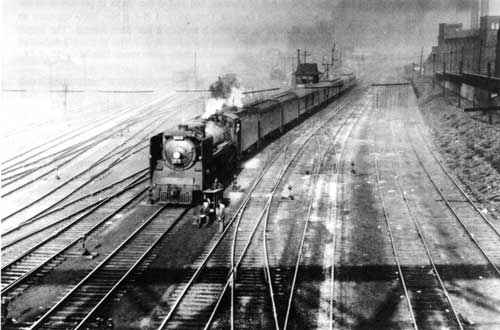
Canadian Pacific Railway Locomotive No. 2816 arrving at Toronto, Ontario,
on July 9, 1948, with eastbound Train No. 8. note the smoke deflectors
or "elephant ears" alongside the smokebox, which are no longer on the
locomotive.
Photo by Elmer Treloar, Steamtown Foundation Collection
F. Nelson Blount acquired Hudson No. 2816 for the Steamtown Foundation in January 1964, by which time those smoke deflectors or "elephant ears" alongside the smokebox had been removed.
No. 2816 is the only H-1-b subclass CPR 4-6-4 to survive, but H-1-d No. 2858 is preserved in the National Museum of Science and Technology in Ottawa, Ontario, and H-1-e No. 2860 operates an excursion train near Vancouver, British Columbia, for which service it has been named "The Royal Hudson," although it was neither the original Royal Hudson nor of the true Royal Hudson subclass of H-1 4-6-4 locomotives.
Condition: The condition of this locomotive is fair; it has operated about 35,000 miles since it was last shopped.
Recommendation: This locomotive is at present the only 4-6-4 type in the Steamtown collection and for that reason should be preserved by the National Park Service. If any major overhaul to restore the locomotive either for exhibit or for service ever is undertaken, it should be preceded by a report, which should include a thorough physical and operational history of the locomotive prepared by an experienced railroad historian and research in relevant Canadian archives, railway museums, and historical organizations. The report should determine precisely during what years the locomotive had smoke deflectors, and whether more than one type was used. It should also determine whether the engine carried more than one color and lettering scheme, and if so, precisely what those were. In addition to photographs, physical analysis of paint layers and lettering and striping layers should be done to determine color and placement of such decoration, with careful tracings made to serve as the basis for stencils. The report should then recommend to which period the locomotive should be restored.
BIBLIOGRAPHY
Guide to the Steamtown Collection. Bellows Falls, Vt.: Steamtown Foundation, n.d. (ca. 1973), Item No. 38 and roster entry.
Lavallée, Omer. Canadian Pacific Steam Locomotives. Toronto: Railfare Enterprises Ltd., 1985: 178-221, 315, 421, 454.
Stagner, Lloyd E. North American Hudsons: The 4-6-4 Steam Locomotive. David City: South Platte Press, 1987: 28-33, back cover.
CANADIAN PACIFIC RAILWAY NO. 2929
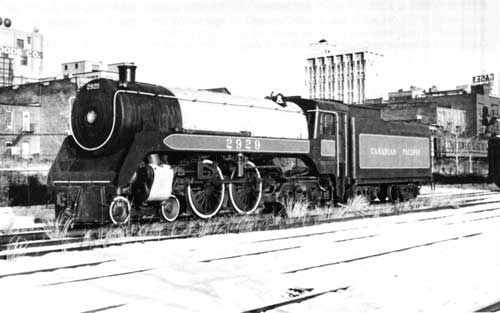
Owner(s):
Canadian Pacific Railway 2929
Whyte System Type: 4-4-4
Class: F-1-a
Builder: Canadian Locomotive Company
Date Built: March 1938
Builder's Number: 1943
Cylinders (diameter x stroke in inches): 16.5 x 28
Boiler Pressure (in lbs. per square inch): 300
Diameter of Drive Wheels (in inches): 75
Tractive Effort (in lbs.): 25,900; also reported as 26,000
Tender Capacity:
Coal (in tons): 12
Oil (in gallons): Not applicable
Water (in gallons): 7,700 (Imperial gallons)
Weight on Drivers (in lbs.): 111,000 (another source claims 111,250)
Remarks: Sold June 1959 to Edaville.
Canadian Pacific Railway 4-4-4 Locomotive No. 2929
History: Canadian Pacific Railway Locomotive No. 2929 constituted the last in a series of twenty locomotives, Nos. 2910 through 2929, built by the Canadian Locomotive Company, Limited, expressly for service on streamlined "lightweight" passenger trains, a then-recent development. This particular specimen of Class F-1-a locomotive was outshopped by the Canadian Locomotive Company in March 1938. Actually, this class of 4-4-4 "Jubilee" type locomotives followed five earlier locomotives of Class F-2-a. Those earlier 4-4-4s were slightly larger and more powerful locomotives. Both classes of 4-4-4s featured streamlined exteriors appropriate for their service. The streamlined design of No. 2929 is somewhat reminiscent of streamlining used on a Delaware, Lackawanna & Western locomotive of a different wheel arrangement once photographed in the Scranton yard.
Canadian Pacific historian Omer Lavallée provided the context for the design of these locomotives under the supervision of long-tenured motive power chief Henry Blaine Bower:
Despite the effects of the Depression, many railways found the resources to experiment with then-new concepts such as diesel motive power and high-speed, lightweight trains, usually in articulated, fixed-length consists as on the Burlington, Union Pacific and Boston & Maine. Other lines, including the Baltimore & Ohio and the Milwaukee Road, continued to think in terms of steam motive power and variable-length trains composed of individual cars, as did Canadian Pacific.
Brilliant steam locomotive advocate though he may have been, Bower proved no accurate prognosticator of the future when he wrote, "The Diesel engine of today, wonderful as it is, is doubtful as a lasting standard and it seems a reasonable prediction that it will be considered obsolete in a short period of years." Lavallée continued:
So wrote Bowen in 1935, as his drawing office was engaged in designing a number of new lightweight trains which were to be hauled by 4-4-4 type semi-streamlined locomotives equipped with 80-inch driving wheels having disc, rather than spoked, centers, and boilers carrying steam at 300 pounds pressure per square inch. Emphasis was placed on semi-streamlining:". . . no extremes (have) been resorted to from a streamlining point of view, and yet it is felt that the same results will be accomplished in diminishing head-end resistance as with the more extreme designs which have been resorted to by . . . other railroads . . . (which) . . . will not meet safety appliance requirements and make parts very inaccessible for repairs."
The first of the new class F2a 4-4-4 locomotives made its appearance at 1130 on Monday, 27 July 1936. III No. 3000 emerged under steam from the erecting shop at Montreal Locomotive Works, tearing through a canvas mural carrying a drawing of the front of Brown class S.C. 4-4-0 I No. 371, which had been built fifty years before, in 1886. The dignitaries, headed by CPR chairman and president Sir Edward Beatty; W.C. Dickerson, president of MLW, and Camillien Houde, mayor of Montreal, learned that as a publicity gesture, the 4-4-4 wheel arrangement had been given the type name "Jubilee" by the CPR to mark the fiftieth anniversary of the inauguration of its transcontinental service. The second locomotive of this class, No. 3001, was soon on its way to western Canada heading an exhibition train, going as far as Vancouver on the main line and returning via the Kettle Valley and Kootenay route through southern British Columbia before being placed in regular service between Calgary and Edmonton. Nos. 3000 and 3002 were assigned to service between Toronto and Windsor, Ont., while Nos. 3003 and 3004 were put into operation between Montreal and Quebec. All remained in their respective areas until withdrawal twenty years later.
The class F2 4-4-4s featured nickel steel boilers and the extensive use of high strength alloys in construction. Interestingly, the main rods were connected to the leading drivers, in the manner of a 4-4-0.
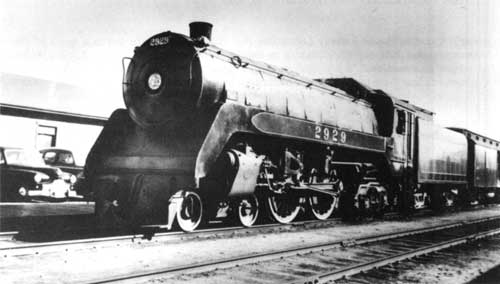
Canadian Pacific Railway 4-4-4
"Jubilee"-type Locomotive No. 2929 appeared at the head of a train in
Fredericton, New Brunswick, on October 21, 1953. The locomotive
undoubtedly crossed Maine to get to New Brunswick.
Collection of
Gerald M. Best, California State Railroad Museum Library
That same year, as Lavallée described, one of the new locomotives set a long-standing speed record for Canadian railroads:
The establishment of official speed records preoccupied mechanical men in North America to the extent that it did on the opposite side of the Atlantic. However, the attainment of the generally-accepted speed record for a Canadian steam locomotive came about in a curious way. In the autumn of 1936, the Canadian Westinghouse Company was asked by Bower to conduct air brake tests on a train of the new lightweight equipment. A consist was made up, headed by class F2a 4-4-4 No. 3003, pulling a train composed of mail/express car 3603, baggage/buffet car 3053 and coaches 2105 and 2107. On 18 September 1937, eastbound from Smiths Falls to Montreal, the train was brought up to high speed. Near mile 38 of the Winchester Subdivision (about one mile west of Soulanges), the brakes were applied in emergency. The test established that the train required 2,227 m (1 mile, 2025 feet) to be brought to a complete stop, that the brake shoe temperatures on the cars ranged in excess of 360°C. (700°F.) while those of the driving wheel tires was in the order of 315°C. (600°F) However, the report notes that the speed of the train at the moment that the brakes were applied was 181 km/h (112.5 mph). . . .
This speed record remained unchallenged until 10 March 1976, when the Alcan Dofasco-MLW consortium's LRC Train attained a speed of 208 km/h (129 mph) on a test run on CP Rail between St. Jean and Delson, Que., on the Adirondack Subdivision. A few weeks later, on 22 April 1976, the United Aircraft-built Turbo Train, operated by Canadian National Railways, attained 226.2 km/h (140.6 mph) on a test run near Morrisburg, Ontario.
Subsequently, the Canadian Pacific Railway built another 20 "Jubilee" type 4-4-4 locomotives which, despite being later locomotives than the F-2s, had the lower class number. Lavallée explained:
A later series of twenty 4-4-4s, designated class Fla, possessed smaller 75-inch drivers; the main rods were connected to the rear pair. Numbered 2910-2929, these smaller engines were built in 1937. The fast, local intercity services for which the Fis were designed never materialized and they were assigned to secondary local passenger services on the prairies and in eastern Canada. However, one of these assignments, the Regina-Moose Jaw local train, called for the 16.4 km (10.2 miles) between Pasqua and Belle Plaine Sask., to be effected in ten minutes, an average start-to-stop speed in excess of 98 km/h (61 mph). This was, for some time in the late 1940s and early 1950s, the fastest scheduled speed attained by a Canadian passenger train.
Thus the locomotive Canadian Pacific numbered 2929 came into existence, rolling out of the Canadian Locomotive Company's erecting shop in March 1938, last of the Jubilees, last of the 4-4-4s in North America.
Interestingly, although the 4-4-4 type proved unpopular and experienced little use in the United States, it had been tried there, even if unsatisfactorily. The first trial occurred in 1915 when the Philadelphia and Reading Railroad obtained four Class C-1a 4-4-4 locomotives: No. 110, built in May 1915; No. 111, built in June 1915; and Nos. 112 and 113, built in July 1913. These had 23-1/2-inch diameter cylinders with a 26-inch stroke and 80-inch diameter drive wheels, and carried 240 pounds per square inch boiler pressure. They lasted less than a year before being rebuilt as 4-4-2 Atlantic type engines.
Many years passed, and then another single American 4-4-4 appeared two years before Canada's first. Did the American 4-4-4 inspire Bowen to design a Canadian counterpart in 1935? No evidence has been found to either prove or disprove that evolution. But in 1934, the Baltimore and Ohio Railroad erected in its own shops, or to be more precise, altered an existing 4-4-2 into a Class J-1 4-4-4 named the Lady Baltimore, which became B & O Locomotive No. l. Along with Locomotive No. 2, the Lord Baltimore, a Class V-2 4-6-4 Hudson type, the Lady Baltimore was designed to pull new lightweight streamlined passenger trains: the Lord Baltimore received assignment to the Royal Blue and the Lady Baltimore to the Abraham Lincoln on the Alton (a wholly owned Baltimore & Ohio subsidiary that was originally the Chicago & Alton Railroad). The Lady Baltimore should have done well on the Alton Railroad, which featured easy grades and long tangents (stretches of straight track), but it did not. Later, the locomotive went back to Mt. Clare Shops in Baltimore where it received a conventional cab and front end to replace streamlined components, being renumbered 5330. Its low tractive effort and large drive wheels, conducive to speed, not power, continued to be a handicap. The Baltimore & Ohio placed it in service for a while on its Wheeling Division, hauling local passenger trains between Holloway and Cleveland, Ohio, but ultimately sent the locomotive to the Riverside Shop in Baltimore to be preserved in white lead for a year or so. The railroad finally scrapped the locomotive in 1949. This apparently was the second experiment with the 4-4-4 type on an American railroad; one or more other examples of American 4-4-4s have been rumored to exist, but none are confirmed.
However, another American 4-4-4 was designed, in the same year the Baltimore & Ohio built the Lady Baltimore, though it never was built.
As David P. Morgan wrote in Trains, when articulated, lightweight diesel-powered streamlined trains started showing up in 1933, the chief engineer of the Lima Locomotive Works quickly recognized their competitive virtues, and believed that lightweight standard equipment would be a wave of the future. He also believed that Lima should be able to offer a suitable streamlined steam locomotive to railroads in search of motive power for such trains. Thus in September 1934, Lima Vice President Will Woodard authored an article published in Railway Age accompanied by plans for a semi-streamlined 4-4-4 equipped with 84-inch diameter drive wheels, poppet valves, and a booster on the trailing truck. Woodard projected a sustained 2,200 horsepower at all speeds above 30 miles per hour, with a top speed estimated conservatively at 100 miles per hour. "This was more than enough power," commented David Morgan, "to keep a six-car, 250-ton train rolling at a consistent 90 miles per hour over tangent [straight] level track." Morgan went on to analyze the virtues of the proposed Lima 4-4-4:
The 4-4-4's booster increased her starting tractive effort to 43,100 pounds in spite of the 84-inch drivers, and once she was under way the big wheels held machinery speeds down to reasonable levels. Moreover, the cylinders drove on the first pair of drivers--a principle which Woodard pointed out "was one of the great virtues of the old eight wheelers [4-4-0]" as a contribution to smoother operation. The popped valves separated the timing of admission and exhaust of steam within the cylinders, which would have increased her horsepower at 100 miles an hour by as much as 50 percent over conventional or Walschaerts gear.
The design of the smallest details revealed painstaking care: the boiler was to be constructed from nickel steel, tender trucks were of welded design, and the booster was a comparatively high-speed unit--cutting out at 20 miles an hour.
Unfortunately, Lima Locomotive Works never built this locomotive that Woodard's engineers had designed.
The differences between this proposed Lima 4-4-4 and the Lady Baltimore, however, may explain why the latter did not succeed and inspire the construction of sister engines. The drive rods on the Lady connected to the rear pair of drivers rather than to the front pair, as on the Lima proposal. Equally important, the Lady Baltimore carried much smaller cylinders and constituted a much lighter locomotive, one that developed at a theoretical 100 miles per hour only 1,570 horsepower compared with 2,200 for the proposed Lima engine.
To return to the subject of the Canadian 4-4-4s, which may or may not have derived from the American designs, the operational history of the last of the F-1-a locomotives, No. 2929, has yet to be researched, but it is known to have operated between Montreal and Fredericton, New Brunswick, in October 1953, which required it to cross the state of Maine, though whether under its own power, pulled by an American locomotive, or, on different occasions, both, is yet unknown. Canadian Pacific historian Omer Levallee photographed in color Locomotive No 2929 hauling Train No. 427 between Montreal and Ottawa in the spring of 1957. In June 1958, No. 2929 ran between Montreal and Farnham.
In June 1959, F. Nelson Blount purchased No. 2929 from the Canadian Pacific for exhibit either at his Edaville property at South Carver, Massachusetts, or in one of the amusement parks with which he then had a contract for display of historic locomotives.
One locomotive of this Canadian Pacific F-1-a class survives in Canada, No. 2928, exhibited in the Canadian Railway Museum at Delson, Quebec, so the presence of No. 2929 in the United States does not leave Canada without a representative of the type. Apparently no examples of Canadian Pacific Class F-2-a locomotives survive.
Condition: This locomotive is capable of being restored to operable condition. However, it is not really suitable for regular excursion train service, though it would be suitable for demonstration around the Scranton yard or in occasional short runs over fairly level terrain scheduled only periodically. One of the characteristics of a locomotive with large drive wheels is the capability of reaching high speeds, but at the cost of pulling power or tractive effort. In other words, this locomotive is fast but not powerful.
Recommendation: This locomotive should be preserved by the National Park Service on the grounds that: (1) it is the only 4-4-4 locomotive in the United States; (2) it is the only semi-streamlined locomotive in the Steamtown collection and the only locomotive designed expressly to power lightweight streamlined passenger trains developed during the 1930s; and (3) it did cross Maine historically during its common carrier service for the Canadian Pacific Railway and is thus an example of a Canadian locomotive that operated in the United States historically. At some future time a report, should be completed about this engine by a qualified railroad historian, and should involve in-depth research in Canada into the operational history of this locomotive. The locomotive should be restored mechanically for occasional operation as a historic locomotive. It should not be used in regular excursion train service.
BIBLIOGRAPHY
Craig, Allan E. "Canadian Pacific 4-4-4." Model Railroader, Vol. 30, No. 12 (Dec. 1965): 38, 39.
"Famous Steam Locomotives: 14; Light, Fast and Neat as a New Pin." Trains, Vol. 13, No. 16 (Apr. 1953): 36, 37.
Guide to the Steamtown Collection. Bellows Falls, Vt.: Steamtown Foundation, n.d. (ca. 1973), Item no. 39 and roster entry.
Hart, George M. "History of the Locomotives of the Reading Company." The Railway and Locomotive Historical Society Bulletin, No. 67 (May 1946): 86.
Lavallée, Omer, ed. Canadian Pacific Railway Diagrams and Data. Toronto: Railfare Enterprises Ltd., 1985: 17.
__________. Canadian Pacific Steam Locomotives. Toronto: Railfare Enterprises Ltd., 1985: 194-196, 316,416, 437, 441, 455.
Locomotive Cyclopedia of American Practice, 1941. New York: Simmons-Boardman Publishing Corp., 1941: Section 2, 179-182.
Locomotive Cyclopedia of American Practice, 1947. New York: Simmons-Boardman Publishing Corp., 1947: Section 2, 158.
Mead, Edgar T. Telephone interview with author, Apr. 12, 1988.
Morgan, David P. "The Lima Story, Part II: Blueprint Locomotives." Trains, Vol. 12, No. 5 (Mar. 1952): 20-21.
Sagle, Lawrence W. B & O Power: Steam, Diesel and Electric Power of the Baltimore and Ohio Railroad, 1829-1964. n.p.: Alvin F. Staufer, 1964: 289, 302, 303.
| <<< Previous | <<< Contents>>> | Next >>> |
stea/shs/chap3.htm
Last Updated: 14-Feb-2002
